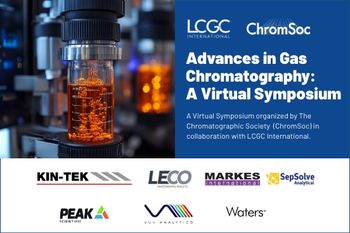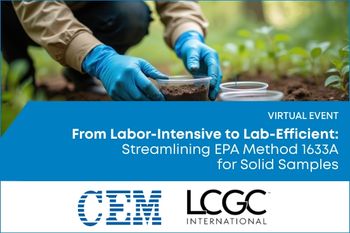
- Special Issues-10-01-2015
- Volume 33
- Issue 10
New Solutions to Environmental Challenges
A brief introduction to the articles presented in this supplement.
Environmental science and analytical chemistry are intimately intertwined. New methods are continually needed to address emerging challenges, which often comprise complicated matrices and ultratrace levels of chemical constituents. Further, the breadth of chemicals of interest spans a wide range of metals, ions, small organic compounds, complexes, and nanoparticles. Because of the diversity of this group of samples, researchers need access to a wide range of analytical methods. While multitude standardized methods, such as those curated by the U.S. Environmental Protection Agency (EPA), are available for guidance, some of these are not compatible with the problem at hand. Further, the evolution of analytical instrumentation continues to provide novel means to accelerate workflows. We should not be beholden to outdated methods; rather, we should continually strive to push the boundaries, to make analyses cheaper, more portable, more reliable, more sensitive, and more available.
In this special issue, we provide a snapshot of emerging applications and solutions in environmental analytical chemistry. The compilation includes a wide range of instrumental techniques. The uses of sample preparation, spectroscopy, liquid and gas chromatography (LC and GC), and mass spectrometry (MS) are shown to span a variety of operation modes, formats, and applications. Further, we feature contributions from academic and industry groups in the United States and Europe.
On the spectroscopy side, a new instrument developed by Dasgupta and coworkers provides impressive performance and portability for arsenic measurements in water. The primary mode of detection is through gas-phase chemiluminescence, and both laboratory-scale and portable (<5 kg weight) instruments have been designed and constructed to be simple, but effective. Such a development provides means for low-cost analysis of arsenic, which is a significant need worldwide. The maximum contamination limit set by the US EPA for arsenic is 10 µg/L, and the new systems are capable of detecting an order of magnitude below this level, and more than two orders above it. The analysis can be performed in less than 3 minutes.
An interesting new spectroscopy technique has been brought to light in an article prepared by Harris and colleagues. The benchtop system used makes use of sub-terahertz (millimeter wavelength) radiation and Fourier transform molecular rotational resonance spectroscopy (FT-MRR) for absolute structure-specific analyte measurement. This technique alleviates the need for lasers, chromatography, and chemometrics to provide rapid measurement performance in the low picomole range and spanning upwards 3–5 orders of magnitude in dynamic range.
Rounding out our more purely spectroscopy techniques is a great article on the use of inductively coupled plasma–MS (ICP-MS) for single-particle analysis in environmental water samples. Stephan and Thomas describe the detection and analysis of metal nanoparticles at low concentrations, but also with the capability for measuring salient properties such as particle distribution and particle size. In addition to providing an excellent overview of the technology and specific operation modes, they demonstrate the use of the technique for evaluating the effectiveness for removal of TiO2 nanoparticles by wastewater treatment plants, among other water applications.
Rangel and coworkers describe the use of flow injection analysis (FIA) techniques and their potential for analyzing a variety of environmental samples. FIA includes the lab-on-a-valve concept, which is highly modular and flexible in its design. Thus, concepts such as solid-phase spectrometry, where analytes are trapped and detected spectroscopically on beads, can be incorporated into novel flow schemes, which can be automated and are highly reproducible. Further, reagent and sample consumption are reduced. Overall, I think that FIA is an overlooked analytical concept in mainstream laboratories. Fit-for-purpose setups can be robust, reliable, and efficient.
Moving from a focus on spectroscopy to sample preparation and chromatography–mass spectrometry, Usenko and coworkers describe their unique work in oceanographic environmental analysis. The researchers are using whale ear wax as a core sample to study changes in ocean pollution over the life of a whale. What an exceptional idea! Whales can live long lives and traverse many parts of the planet, so interesting spatial and temporal coverage of organic contaminant levels is possible. However, to effectively sample the matrix and analyze for multiple classes of compounds, special attention to sample preparation is needed. Selective pressurized liquid extraction (SPLE) is described and demonstrated for hormone analysis when combined with ultrahigh-pressure liquid chromatography (UHPLC)–MS-MS. SPLE involves the strategic combination of the sample with one or more sorbent materials. The sorbents provide unique selectivity for targeting different compound classes and enable the preparation of samples for both LC and GC analysis.
Finally, my colleagues and I contribute an article from our own work at UT Arlington. For several years, we have been refining and applying a variety of analytical methods to investigate the potential environmental impact of unconventional oil and gas extraction. The article provides an overview of the GC- and ICP-based measurements we and others have made to study water quality. These methods emphasize utility and reliability, but also good throughput for handling large numbers of samples. Thus, analytical results can be accompanied with geospatial analysis to help understand potential sources for contaminants detected.
I want to thank the authors, who have dedicated their time and efforts to communicate their latest technologies, interests, and expertise so that readers can be better versed in the state-of-the-art today. It is my hope that this collection will provide a broad overview of emerging methods in chromatographic and spectroscopic analysis. Specifically, I hope that the articles will inspire readers in their own work, and that the implementation and propagation of the strategies the articles describe can help provide more-comprehensive assessments of analytical problems.
Articles in this issue
Newsletter
Join the global community of analytical scientists who trust LCGC for insights on the latest techniques, trends, and expert solutions in chromatography.




